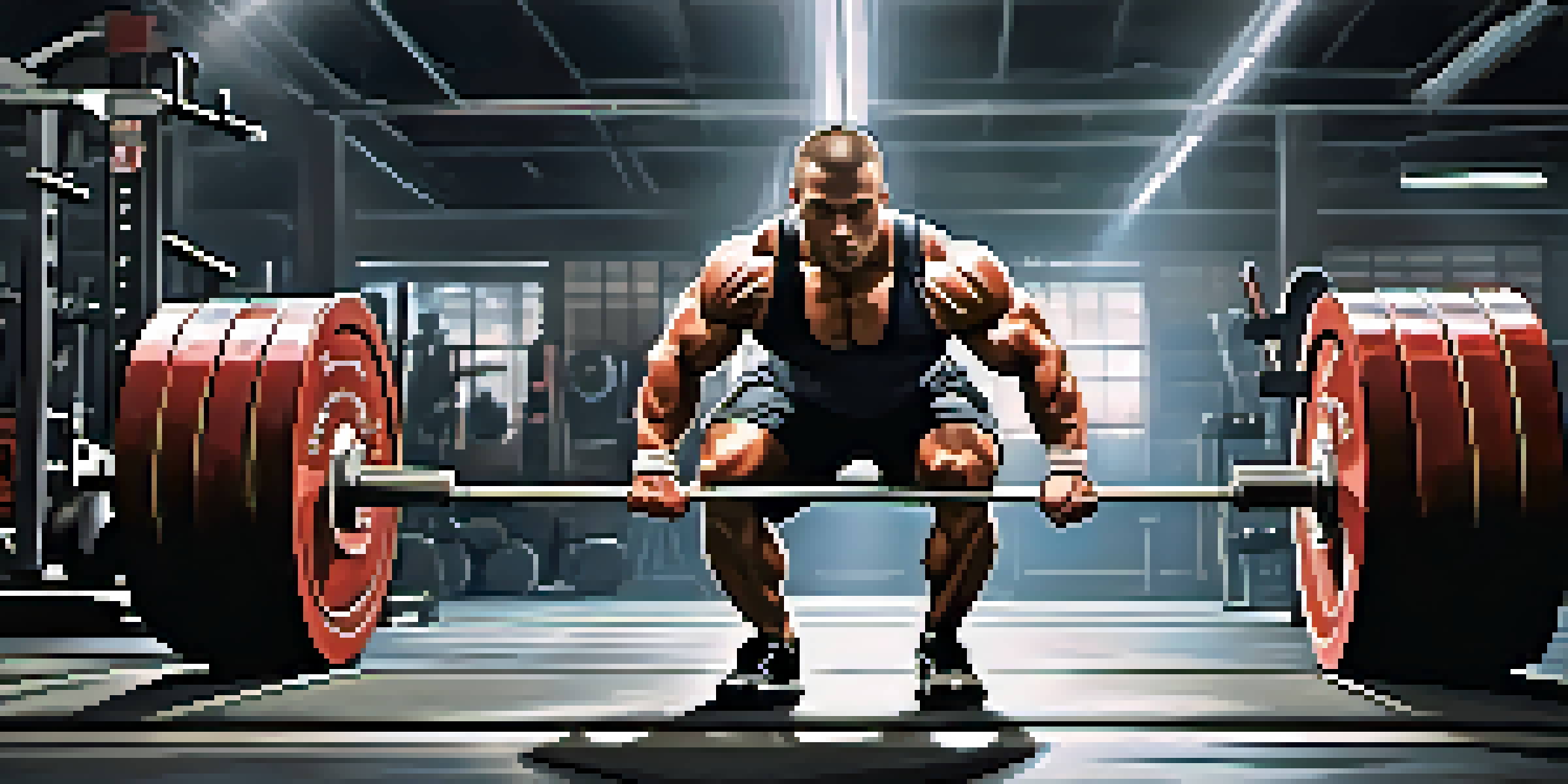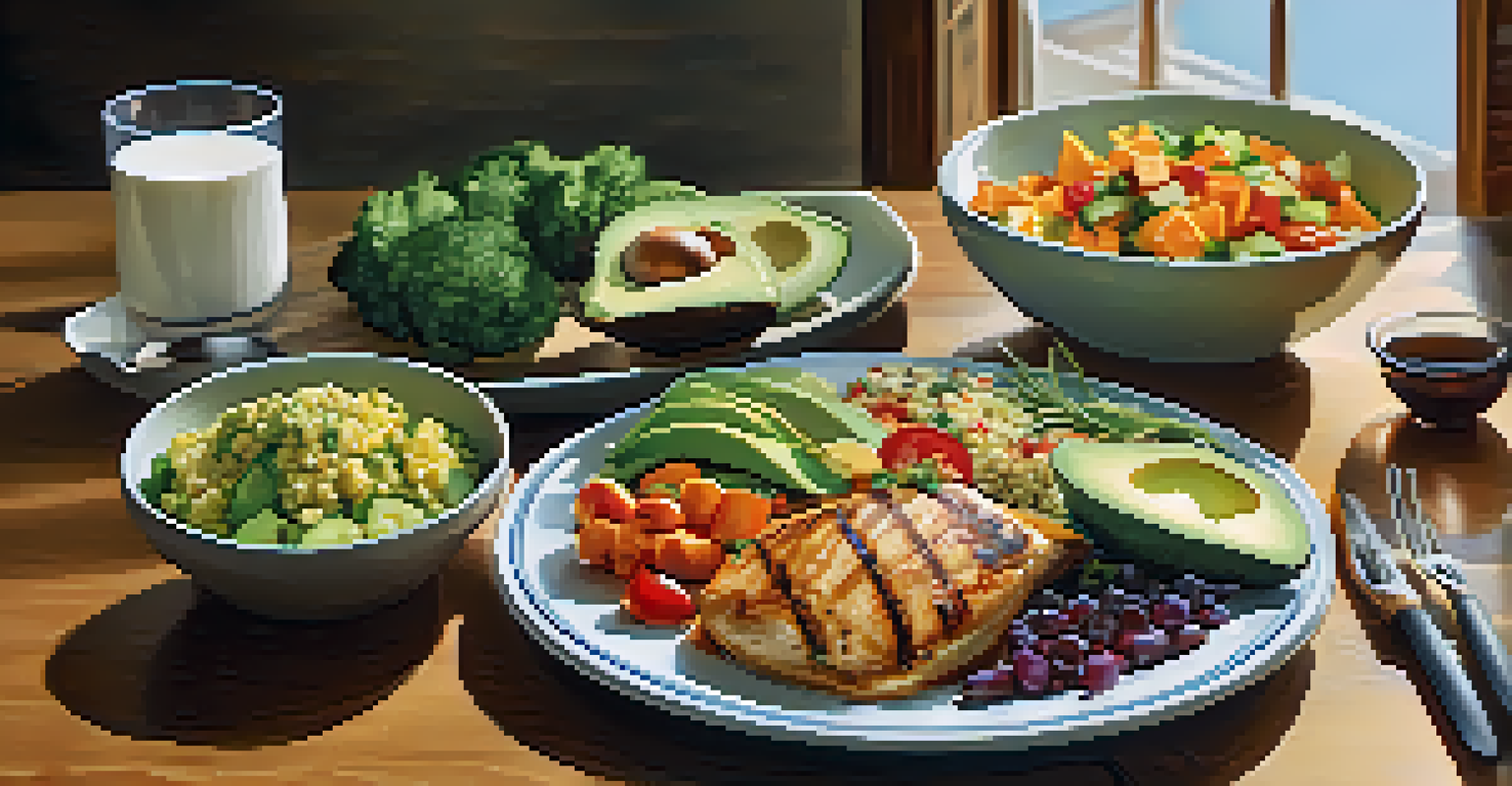Balancing Powerlifting and Bodybuilding for Optimal Gains

Understanding the Basics of Powerlifting and Bodybuilding
Powerlifting and bodybuilding are two distinct disciplines that focus on strength and aesthetics, respectively. Powerlifting revolves around maximizing strength in three specific lifts: the squat, bench press, and deadlift. On the other hand, bodybuilding emphasizes muscle growth and definition through various exercises targeting different muscle groups.
Strength does not come from physical capacity. It comes from an indomitable will.
While powerlifters aim for heavier weights and lower repetitions, bodybuilders typically perform higher reps with moderate weights to promote hypertrophy. This fundamental difference means that training for each can feel quite different, but they can complement each other beautifully when balanced correctly.
Understanding these foundational concepts is crucial for those looking to combine both methods. By knowing the goals and techniques of each, you can tailor your workouts to achieve a well-rounded fitness experience that maximizes both strength and muscle definition.
Setting Clear Goals for Your Training
Before diving into a combined training regimen, it's essential to set clear and realistic goals. Are you looking to increase your lifting capacity, build muscle mass, or perhaps both? Establishing specific objectives will help guide your training and keep you motivated.

For instance, you might decide to focus on building your squat strength while also adding muscle mass to your legs and upper body. This dual approach allows you to track progress in both areas, ensuring that you’re not neglecting either aspect of your fitness journey.
Distinct Goals of Powerlifting vs. Bodybuilding
Powerlifting focuses on maximizing strength in specific lifts, while bodybuilding emphasizes muscle growth and definition through various exercises.
By defining your goals, you create a roadmap for your training. This clarity not only enhances your workouts but also helps you stay committed as you see progress in both powerlifting and bodybuilding.
Creating a Balanced Workout Routine
A well-balanced workout routine is key to successfully merging powerlifting and bodybuilding. A typical structure might include heavy lifting days focused on your main lifts, followed by hypertrophy-focused sessions to target muscle growth. This approach ensures you’re building strength while also sculpting and defining your physique.
The only place success comes before work is in the dictionary.
For example, you might dedicate three days a week to powerlifting, focusing on the squat, bench press, and deadlift. On alternate days, engage in bodybuilding-style workouts that emphasize higher reps and isolation exercises, such as bicep curls or leg extensions.
This balance helps prevent overtraining while maximizing the benefits from both disciplines. By incorporating both heavy lifts and higher-rep exercises, you’re setting yourself up for optimal gains in strength and muscle size.
The Importance of Nutrition in Your Training
Nutrition plays a pivotal role in supporting your training efforts in both powerlifting and bodybuilding. Consuming the right balance of macronutrients—proteins, carbohydrates, and fats—will help fuel your workouts and aid in recovery. A protein-rich diet is essential for muscle repair and growth, particularly when engaging in high-intensity training.
For instance, if your goal is to increase strength, you may need more calories to support your energy expenditure. Including complex carbohydrates, like oats and sweet potatoes, will provide you with sustained energy for those heavy lifting sessions.
Nutrition Fuels Your Training Success
A balanced diet rich in proteins, carbohydrates, and fats is essential for supporting the energy needs and recovery of both powerlifting and bodybuilding.
Balancing your diet to reflect your training goals can lead to better performance and results. Remember that your body needs proper fuel to build strength and muscle; without it, your gains may stall.
Incorporating Recovery Strategies
Recovery is an often-overlooked yet vital aspect of balancing powerlifting and bodybuilding. Intense training can lead to muscle fatigue and soreness, so prioritizing rest days and active recovery is crucial for progress. Techniques such as stretching, foam rolling, and even yoga can enhance recovery and improve flexibility.
Moreover, getting adequate sleep is essential for muscle repair and overall performance. Aim for 7-9 hours of quality sleep each night to allow your body to recover from the physical demands of your combined training.
By incorporating effective recovery strategies, you’ll not only enhance your performance during workouts but also reduce the risk of injury. This approach ensures that your body remains in optimal condition to tackle both powerlifting and bodybuilding challenges.
Tracking Progress and Making Adjustments
To truly benefit from balancing powerlifting and bodybuilding, it’s important to track your progress. Keeping a workout log can help you monitor your lifts and muscle gains over time, allowing you to identify what works best for you. This data can inform adjustments to your routine, whether that means increasing weights or changing up exercises.
For example, if you notice that your squat strength is improving but not your muscle mass, it may be time to incorporate more hypertrophy-focused exercises into your routine. Conversely, if you find that you're gaining muscle but losing strength, you might want to dedicate more time to your powerlifting sessions.
Importance of Recovery in Training
Incorporating proper recovery strategies, like rest days and techniques such as stretching, is vital to enhance performance and prevent injuries in your combined training.
Regularly assessing your progress helps you stay on track to meet your goals. This proactive approach ensures that your training remains effective and aligned with your aspirations in both powerlifting and bodybuilding.
Staying Motivated on Your Fitness Journey
Staying motivated can sometimes be a challenge, especially when balancing two demanding training styles. One effective strategy is to celebrate small victories, whether that's hitting a new personal record in powerlifting or noticing increased muscle definition. These milestones can provide the encouragement needed to keep pushing forward.
Another way to stay engaged is by joining a community or finding a training partner who shares similar goals. Engaging with others can offer support, accountability, and a sense of camaraderie, making your fitness journey more enjoyable.

Ultimately, maintaining a positive mindset and focusing on your progress will help you stay committed to your training. By blending powerlifting and bodybuilding, you can create a fulfilling and dynamic fitness routine that keeps you inspired.